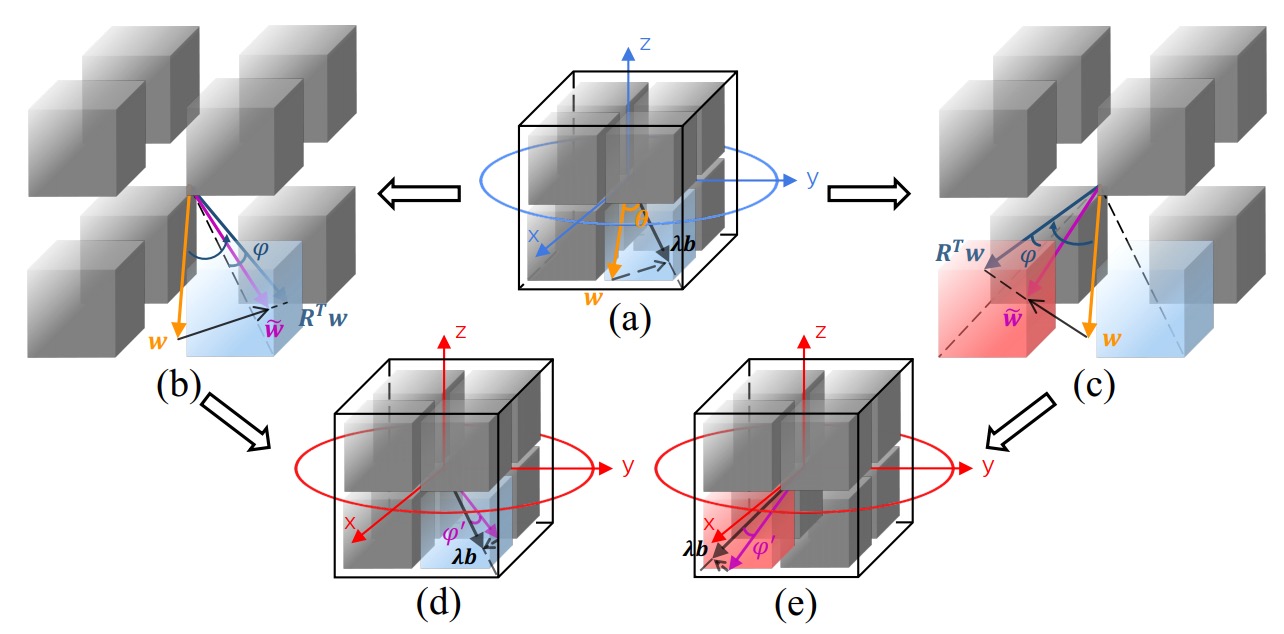Rotated Binary Neural Network (Paper Link)  .
.
Pytorch implementation of RBNN (NeurIPS 2020).
- Python 3.7
- Pytorch == 1.1.0
Any problem, please contact the first author (Email: lmbxmu@stu.xmu.edu.cn) or the third author (Email: ianhsu@stu.xmu.edu.cn). Also, you can post issues with github, but sometimes we could not receive github emails thus may ignore the posted issues (sorry if it happens).
If you find RBNN useful in your research, please consider citing:
@inproceedings{lin2020rotated,
title={Rotated Binary Neural Network},
author={Lin, Mingbao and Ji, Rongrong and Xu, Zihan and Zhang, Baochang and Wang, Yan and Wu, Yongjian and Huang, Feiyue and Lin, Chia-Wen},
booktitle={Proceedings of the Advances in Neural Information Processing Systems (NeurIPS)},
pages = {7474--7485},
year={2020}
}
python -u main.py \
--gpus 0 \
--model resnet20_bireal_1w1a (or resnet20_1w1a or resnet18_1w1a or vgg_small_1w1a) \
--results_dir ./result \
--data_path [DATA_PATH] \
--dataset cifar10 \
--epochs 1000 \
--lr 0.1 \
-b 256 \
-bt 128 \
--Tmin 1e-2 \
--Tmax 1e1 \
--lr_type cos \
--warm_up \optinal arguments:
--results_dir Path to save directory
--save Path to save folder
--resume Reload last checkpoint if the training is terminated by accident.
--evaluate / -e Evaluate
--model / -a Choose model
default: resnet20_bireal_1w1a
options: resnet20_1w1a / resnet18_1w1a / vgg_small_1w1a
--dataset Choose dataset
default: cifar10
options: cifar100 / tinyimagenet / imagenet
--data_path Path to dataset
--gpus Specify gpus, e.g., 0, 1
--lr Learning rate
default: 0.1
--weight_decay Weight decay
default: 1e-4
--momentum Momentum
default: 0.9
--workers Data loading workers
default: 8
--epochs Number of training epochs
default:1000
--batch_size / -b Batch size
default: 256
--batch_size_test / -bt Evaluating batch size
default: 128
--print_freq Print frequency
default: 100
--time_estimate Estimate finish time of the progra
set to 0 to disable
default: 1
--rotation_update Update rotaion matrix every n epoch
default: 1
--Tmin Minimum of param T in gradient approximation function
default: 1e-2
--Tmax Maximum of param T in gradient approximation function
default: 1e1
--lr_type Type of learning rate scheduler
default: cos (CosineAnnealingLR)
options: step (MultiStepLR)
--lr_decay_step If choose MultiStepLR, set milestones.
e.g., 30 60 90
--a32 Don't binarize activation, namely w1a32
--warm_up Use warm up
| batch_size | batch_size_test | epochs | Top-1 | Quantized model Link | Paper data |
|---|---|---|---|---|---|
| 256 | 128 | 1,000 | 92.2% | resnet18_1w1a | ✔ |
| 256 | 128 | 1,000 | 86.5% | resnet20_1w1a | ✔ |
| 256 | 128 | 1,000 | 87.8% | resnet20_bireal_1w1a | ✔ |
| 256 | 128 | 1,000 | 91.3% | vgg_small_1w1a | ✔ |
To ensure the reproducibility, please refer to our training details provided in the links for our quantized models.
If it takes too much time to finish a total of 1,000 epochs on your platform, you can consider 400 epochs instead. It can feed back impressive performance as well, better than the compared methods in the paper.
To verify the performance of our quantized models on CIFAR-10, please use the following command:
python -u main.py \
--gpus 0 \
-e [best_model_path] \
--model resnet20_bireal_1w1a (or resnet20_1w1a or resnet18_1w1a or vgg_small_1w1a) \
--data_path [DATA_PATH] \
--dataset cifar10 \
-bt 128 \python -u main.py \
--gpus 0,1,2,3 \
--model resnet18_1w1a (or resnet34_1w1a) \
--results_dir ./result \
--data_path [DATA_PATH] \
--dataset imagenet \
--epochs 150 \
--lr 0.1 \
-b 512 \
-bt 256 \
--Tmin 1e-2 \
--Tmax 1e1 \
--lr_type cos \
--use_dali \Other arguments are the same as those on CIFAR-10
optinal arguments:
--model / -a Choose model
default: resnet18_1w1a.
options: resnet34_1w1a
We provide two types of dataloaders by nvidia-dali and Pytorch respectively. They use the same data augmentations, including random crop and horizontal flip. We empirically find that the dataloader by Pytorch can offer a better accuracy performance. They may have different code implementations. Anyway, we haven't figured it out yet. However, nvidia-dali shows its extreme efficiency in processing data which well accelerates the network training. The reported experimental results are on the basis of nvidia-dali due to the very limited time in preparation of NeurIPS submission. If interested, you can try dataloader by Pytorch via removing the optional argument --use_dali to obtain a better performance.
nvidia-dali package
# for cuda9.0
pip install --extra-index-url https://developer.download.nvidia.com/compute/redist/cuda/9.0 nvidia-dali
# for cuda10.0
pip install --extra-index-url https://developer.download.nvidia.com/compute/redist/cuda/10.0 nvidia-dali
| batch_size | batch_size_test | epochs | use_dali | Top-1 | Top-5 | Quantized model Link | Paper data |
|---|---|---|---|---|---|---|---|
| 256 | 256 | 120 | Yes | 58.8% | 80.9% | resnet18_1w1a | ✘ |
| 512 | 256 | 120 | Yes | 59.6% | 81.6% | resnet18_1w1a | ✘ |
| 512 | 256 | 150 | Yes | 59.9% | 81.9% | resnet18_1w1a | ✔ |
| 512 | 256 | 150 | Yes | 63.1% | 84.4% | resnet34_1w1a | ✔ |
| 512 | 256 | 200 | Yes | 63.5% | 84.6% | resnet34_1w1a | ✘ |
To ensure the reproducibility, please refer to our training details provided in the links for our quantized models.
Small tips for further boosting the performance of our method: (1) removing the optional argument --use_dali as discussed above; (2) increasing the training epochs; (3) enlarging the batch size for training.
To verify the performance of our quantized models on ImageNet, please use the following command:
python -u main.py \
--gpu 0 \
-e [best_model_path] \
--model resnet18_1w1a (or resnet34_1w1a)\
--dataset imagenet \
--data_path [DATA_PATH] \
-bt 256